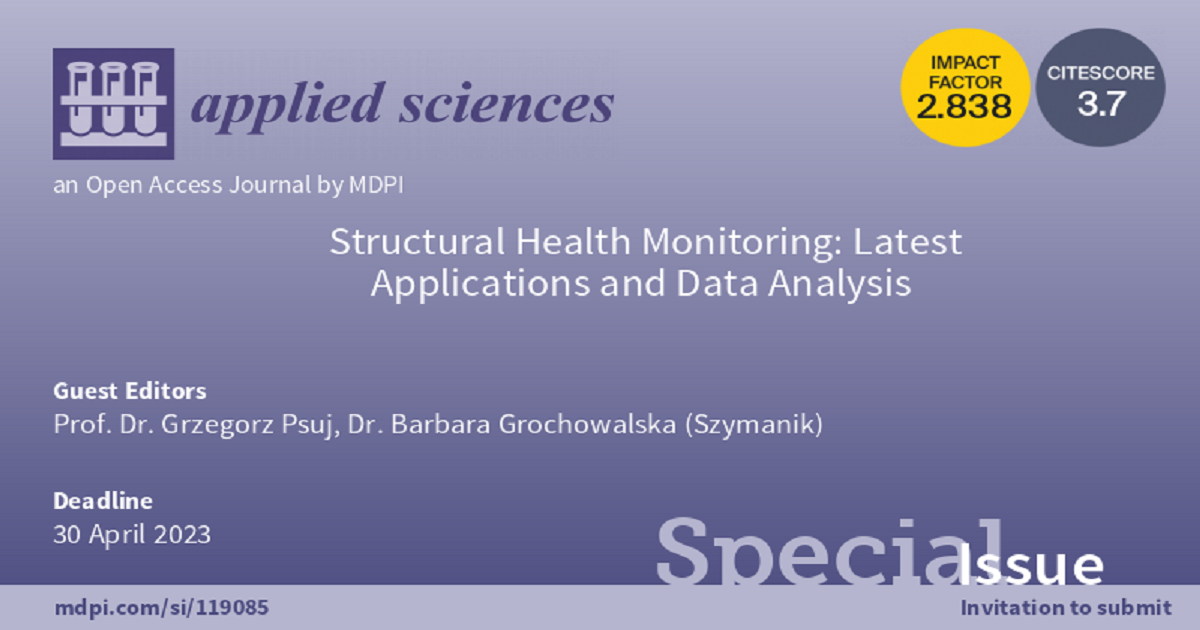Structural Health Monitoring: Latest Applications and Data Analysis
A special issue of Applied Sciences (ISSN 2076-3417). This special issue belongs to the section "Civil Engineering".
Deadline for manuscript submissions: closed (30 April 2023) | Viewed by 14481

Special Issue Editors
Interests: electromagnetic non-destructive testing and evaluation; magnetic sensors; electromagnetic field measurements; multi-sensor measuring systems; sensors network; multi-source data mining and fusion; data processing
Special Issues, Collections and Topics in MDPI journals
Interests: active infrared thermography; microwave heating; numerical modelling; optimisation; neural networks; signal and image processing
Special Issues, Collections and Topics in MDPI journals
Special Issue Information
Dear Colleagues,
This Special Issue is devoted to Structural Health Monitoring (SHM), more precisely to its most recent applications and obtained data analysis. Monitoring the state of engineering structures is unquestionably a timely topic, but it is also a very broad and interdisciplinary one. Both novel sensor systems and measurement, data collecting, and processing techniques are of relevance in this context. SHM techniques encompass all commonly used technical diagnostics and non-destructive testing methods, including electromagnetic, high-frequency, thermovision, radiography, ultrasound, and others. Each of the aforementioned methods presents unique issues, not just in terms of measurement methodology, but data processing as well. As a result, the processing of signals or images for the needs of qualitative and quantitative assessment of the structures under examination is also particularly intriguing in this context.
We invite scientists working in the broad field of technical diagnostics and nondestructive testing to submit original work on any of the above-mentioned themes. All types of research are welcome, including theoretical and experimental studies, as well as comprehensive reviews and surveys.
Prof. Dr. Grzegorz Psuj
Dr. Barbara Grochowalska (Szymanik)
Guest Editors
Manuscript Submission Information
Manuscripts should be submitted online at www.mdpi.com by registering and logging in to this website. Once you are registered, click here to go to the submission form. Manuscripts can be submitted until the deadline. All submissions that pass pre-check are peer-reviewed. Accepted papers will be published continuously in the journal (as soon as accepted) and will be listed together on the special issue website. Research articles, review articles as well as short communications are invited. For planned papers, a title and short abstract (about 100 words) can be sent to the Editorial Office for announcement on this website.
Submitted manuscripts should not have been published previously, nor be under consideration for publication elsewhere (except conference proceedings papers). All manuscripts are thoroughly refereed through a single-blind peer-review process. A guide for authors and other relevant information for submission of manuscripts is available on the Instructions for Authors page. Applied Sciences is an international peer-reviewed open access semimonthly journal published by MDPI.
Please visit the Instructions for Authors page before submitting a manuscript. The Article Processing Charge (APC) for publication in this open access journal is 2400 CHF (Swiss Francs). Submitted papers should be well formatted and use good English. Authors may use MDPI's English editing service prior to publication or during author revisions.
Keywords
- structural health monitoring
- electromagnetic nondestructive evaluation
- technical diagnostics
- magnetic methods
- thermovision
- high-frequency electromagnetic methods
- ultrasound methods
- radiography
- multi-sensor measuring systems
- sensors network
- multi-source data mining and fusion
- data processing
- image processing
- numerical modelling
- optimisation
- neural networks
- machine vision
- machine learning






